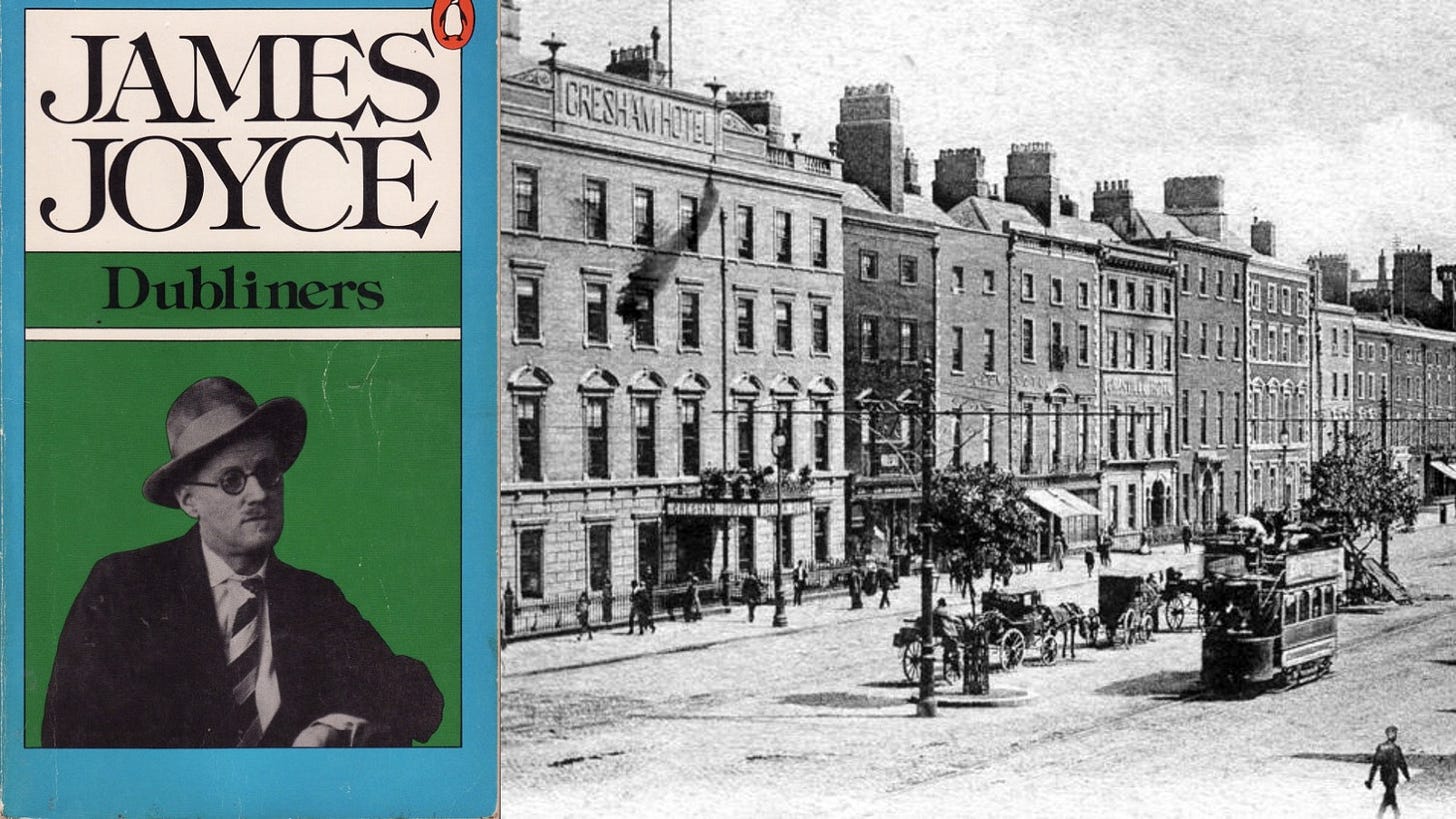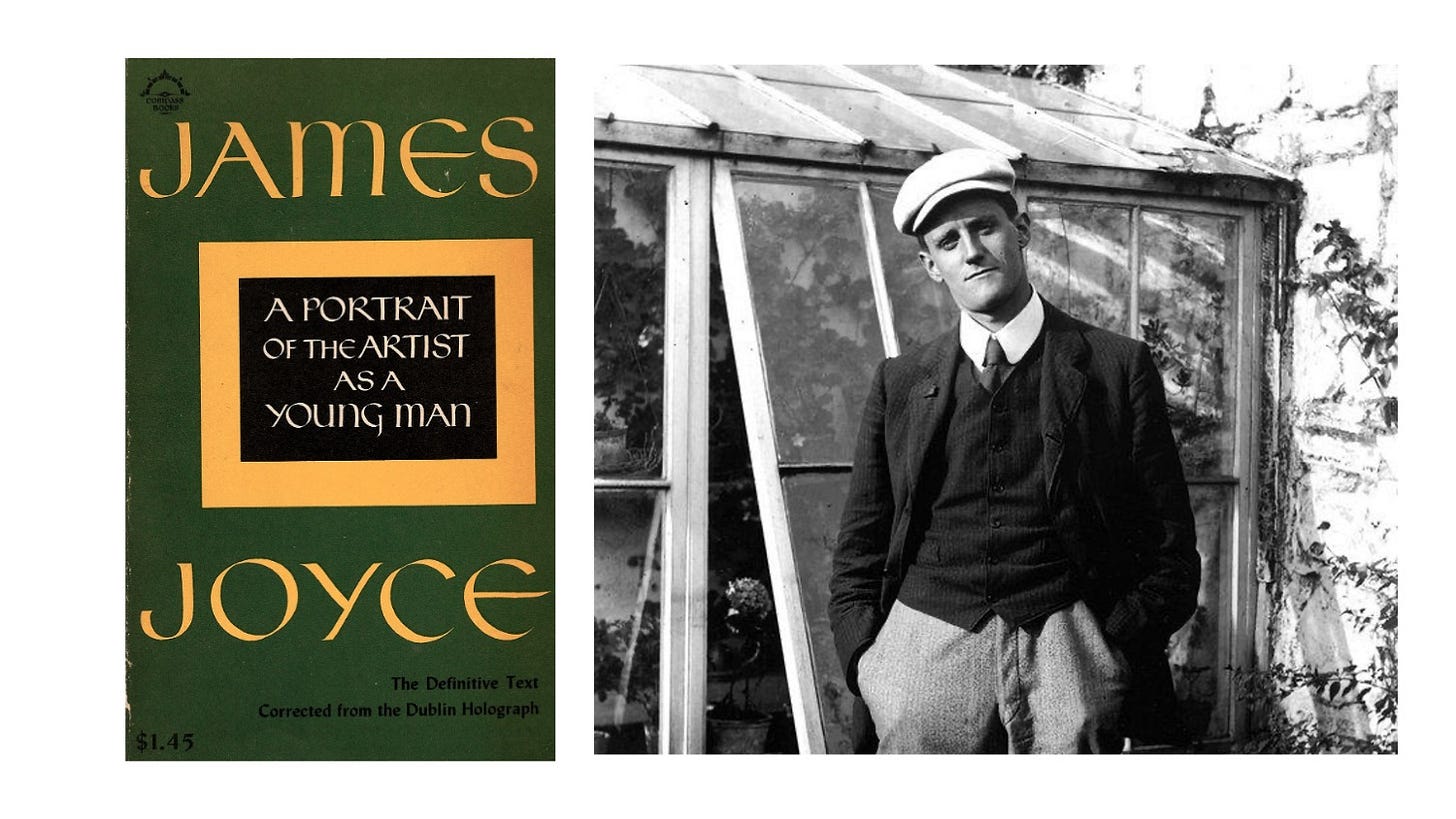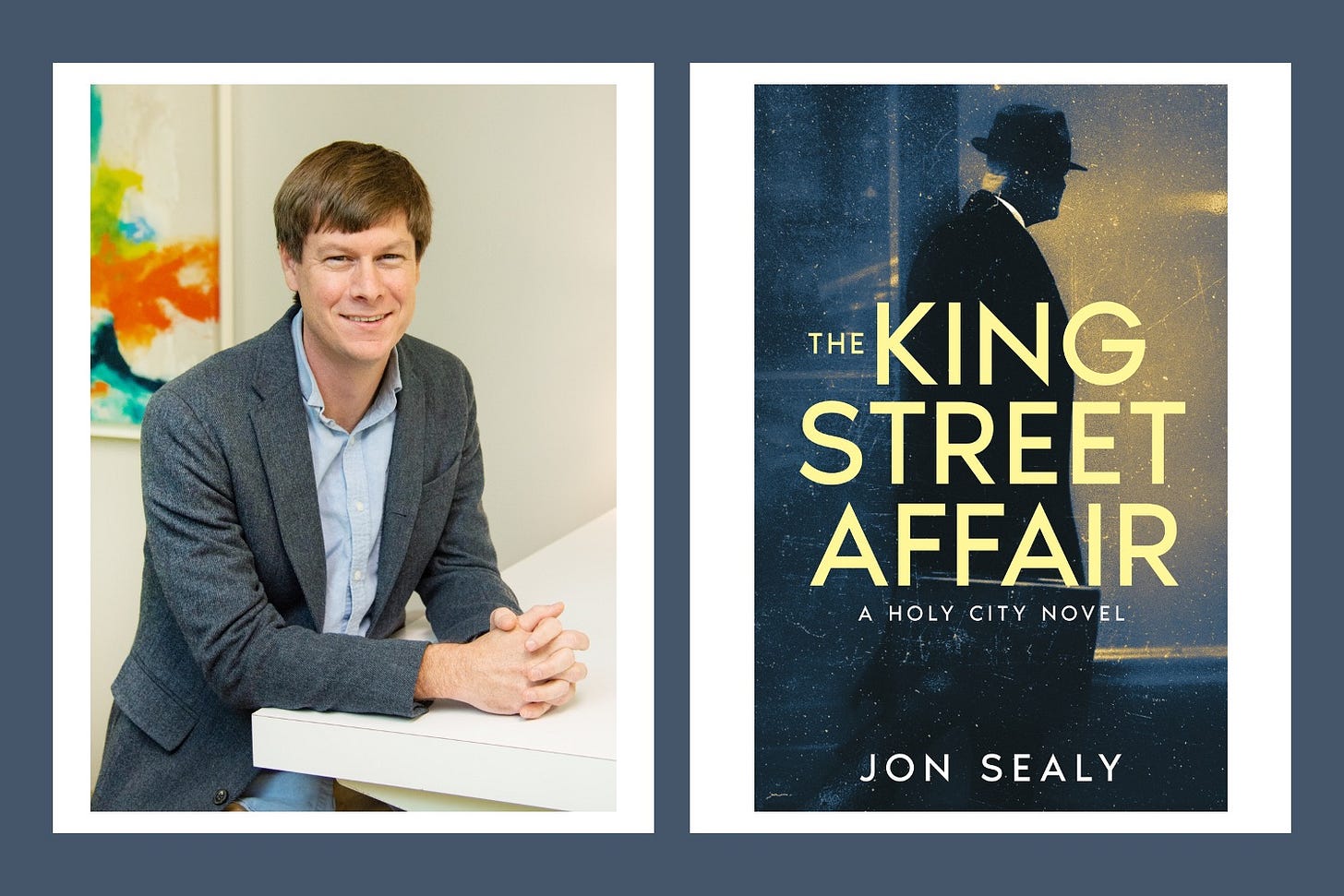Rereading James Joyce
A gentle critique of Dubliners and A Portrait of the Artist as a Young Man
I’ve reached an age where I can revisit authors I studied in high school or college and find them totally alien. After more than 20 years, I can remember the circumstances of reading certain books, and in some cases I can remember my state of mind in approaching the work, yet looking at the same words on the page now, I’m baffled. Did I actually read this? What did I get out of it?
Last month I reread James Joyce’s Dubliners for the first time since I was a freshman in college and then A Portrait of the Artist as a Young Man for the first time since I was a senior in high school. My first reaction was that, since there is so much inside baseball about Irish politics and the Catholic Church, I don’t see how I got anything out of these books at 18.
My second reaction is that although Joyce remains a powerhouse of language, these first two books strike me as products of an immature mind swept up in ego. There’s a hint in Ulysses (which I dipped into but did not reread last month) that Joyce might agree with this assessment.
Paralysis in Dubliners
Joyce, born in 1882, began submitting this book of short stories for publication in 1905. Although he couldn’t find a publisher until 1914 (when he was 32), he wrote most of these stories around age 22—and it shows.
He had a Jesuit education, so his language, use of detail and pacing are all off the charts in terms of technique, but his vision is rather sour. With the exception of “The Dead” (which I would say is full of heart and a contender for the best short story ever written), the stories in this collection are one brutal encounter after another:
“Sisters” is about a boy confronting the death of a local priest, and he ruminates on the word “paralysis,” the core affliction for many of the characters in Dubliners: “But now it sounded to me like the name of some maleficent and sinful being. It filled me with fear, and yet I longed to be nearer to it and to look upon its deadly work.”
“Two Gallants” is about a pair of young men, one of whom, Lenehan, wanders “listlessly” around Dublin thinking about his wasted life, while the other one seduces a woman so he can weasel some money out of her. Lenehan “found trivial all that was meant to charm him and did not answer the glances which invited him to be bold.” Paralysis, again.
In the most brutal story, “Counterparts,” a man ducks out of his work as a scrivener, spends his wages getting drunk, and then goes home and beats his child. Joyce offers clues that the man’s alcoholism might be, in part, a symptom of Irish political oppression (he works at an office of English-sympathizing Protestants), but he’s also just a brute.
When the character loses an arm wrestling match in the pub, “Farrington’s dark wine-coloured face flushed darker still with anger and humiliation at having been defeated by such a stripling.”
Joyce’s Vision of Dublin
The sentence above from “Counterparts” could be a tagline for the entire collection. My edition (Penguin) has an introduction from the scholar Terrence Brown, in which he quotes from Joyce’s letters. Joyce wrote that he wanted the book to represent “a chapter of the moral history of my country,” and that:
It is not my fault that the dour of ashpits and old weeds and offal hangs round my stories. I seriously believe that you will retard the course of civilization in Ireland by preventing the Irish people from having one good look at themselves in my nicely polished looking-glass.
The story “Eveline” is a great example of Joyce’s “looking-glass,” his particular view of the world. It opens with a young woman staring out a window: “She sat at the window watching the evening invade the avenue. Her head was leaned against the window curtains and in her nostrils was the odour of dusty cretonne. She was tired.”
She was tired. The city is oppressing her. But when a young man invites her to run away with him to South America, she goes with him to the docks but then clings to the rail on shore as the young man boards the boat and calls out for her. “She set her white face to him, passive, like a helpless animal,” Joyce writes.
It seems we as readers are meant to look on Eveline with pity. She should have gotten out! But she failed, “a helpless animal,” a representative of the entire city.
Is this vision of Dublin in the early 20th century correct? Maybe, but from my experience as an author and from reading fiction set in places I know well, authors tend to frame their stories around one particular vision—their own unique “looking-glass.” Like a photo filtered on Instagram, you see an artificial version of the scene rather than the scene-as-it-is.
In other words, Joyce has put a filter over Dublin to show us a dirty city full of drunks and rogues, people so stagnant they can’t even get on the boat when the opportunity presents itself. Or maybe this is just a portrait of a young man who wants to get out himself. Unlike Eveline, Joyce sails off for a life on the continent—Paris, Zurich, Trieste.
James Baldwin once wrote, “All art is a kind of confession, more or less oblique.” In Dubliners, we’re not seeing stories of a city. We’re seeing the vision of a 22-year-old disaffected with his home town, a talented writer focused on the “ashpit and old weeds.”
The Portrait of the Artist
Some of the stories in Dubliners are powerful, but they’re also not particularly generous in spirit. This same vision continues in Joyce’s first novel, The Portrait of the Artist as a Young Man, begun when he was in his early 20s and published in 1916.
His protagonist, Stephen Dedalus, is a Joyce-like figure whose family falls on hard times. We see him at home and at boarding school. We see him as a teenager visiting prostitutes, and as a penitent going to confession to renew his faith. Then we see him as he comes of age, abandoning his faith for the life of an artist on his way out of town.
Two quotes toward the end prop up a triumphant vision of the Modern artist, pursuing freedom above all else. First, toward the end of the novel, Stephen and his friend Cranly go on a walk, discussing duty, religion, art, Stephen’s future, and more. Stephen argues:
I will not serve that in which I no longer believe whether it call itself my home, my fatherland or my church: and I will try to express myself in some mode of life or art as freely as I can and as wholly as I can, using for my defence the only arms I allow myself to use, silence, exile and cunning.
A few pages later, he writes in his diary, “Welcome, O life! I go to encounter for the millionth time the reality of experience and to forge in the smithy of my soul the uncreated conscience of my race.”
In the vision of a young James Joyce, Dublin is a paralyzed old city, oppressed by English politics and the Catholic Church. What the city needs is a capital-A Artist, unshackled and free to express his humanity from the exile of Paris, Moulin Rouge-style.
As a young man, I thought the end of Portrait represented a nice mini-manifesto for being an artist, but these days, on the other side of forty, I’m more drawn to his friend Cranly’s side of the argument.
On their walk, Stephen explains his mother wants him to take the Eucharist at Easter, but he won’t do it because he no longer believes in it. Cranly advises him that he should do it anyway: “Do as she wishes you to do. What is it for you? You disbelieve in it. It is a form: nothing else. And you will set her mind at rest.”
Stephen may be putting on the brave face of an artist unshackled from the Church, but he’s still trapped. His quarrel is with himself, not with the Church (or Dublin).
Later, Cranly reminds him, “There are many good believers who think as you do. Would that surprise you? The church is not the stone building nor even the clergy and their dogmas. It is the whole mass of those born into it.”
Later still, Cranly wraps up the discourse with, “Alone, quite alone. You have no fear of that. And you know what that word means? Not only to be separate from all others but to have not even one friend.”
The Artist Matures?
After this debate between the artist yearning for freedom and the friend reminding him of duty and community, Joyce sets Stephen loose on the world in what I presume is meant to be a triumphant success.
In the world according to early Joyce, Stephen is the hero. Dublin is stifling, so the artist must choose the “freedom” of exile over family and community. In this world, Stephen rejects even his own mother. What are we supposed to make of that?
Perhaps Stephen is a stand-in for Joyce, and Joyce gave us some of the highest art written in English since Shakespeare. Perhaps that worked for one man, James Joyce, but it’s a heartless vision for life at scale.
I say: Cranly is right. Stephen (and his ego) is full of it.
I suspect the older James Joyce might agree with me. In his next novel, Ulysses (serialized a few years after Portrait), he brings Stephen home from Paris, seemingly with his tail between his legs. Rather than forging “the uncreated conscience of [his] race,” Stephen is back in Dublin, languishing as a teacher, getting taken advantage of by friends, and haunted by his mother’s death:
She had loved his weak watery blood drained from her own. Was that then real? The only true thing in life? His mother’s prostrate body the fiery Columbanus in holy zeal bestrode. She was no more: the trembling skeleton of a twig burnt in the fire, an odour of rosewood and wetted ashes. She had saved him from being trampled under foot and had gone, scarcely having been.
We learn in the opening pages that not only would Stephen not take the Eucharist to put his mother’s mind at ease, but he wouldn’t even pray for her on her deathbed. Like Cranly, Stephen’s new friend Buck Mulligan chastises him:
You could have knelt down, damn it, Kinch, when your dying mother asked you, Buck Mulligan said. I’m a hyperborean as much as you. But to think of your mother begging you with her last breath to kneel down and pray for her. And you refused. There is something sinister in you…
This makes me think of another favorite quote from James Baldwin: “People pay for what they do, and still more for what they have allowed themselves to become, and they pay for it very simply: by the lives they lead.”
Ulysses is less assuredly on Stephen’s side (here, Leopold Bloom is the star). Joyce’s vision, arguably, has softened and expanded to be more generous. While some of the characters in Ulysses are still trapped, we at least see the consequences of selfishness and the possibility of regeneration.
Does that generosity extend to Joyce’s last major work, Finnegan’s Wake? I’ve never made it through more than a few pages of that absurdity, but if you’ve read it, let me know.
More from Jon Sealy:
To read about some of my characters in trouble, consider buying a copy of my latest novel, The King Street Affair. If you are an author trying to figure out what to do with a manuscript, I also offer a limited number of consulting engagements every year. Learn more here.







